Premium Only Content
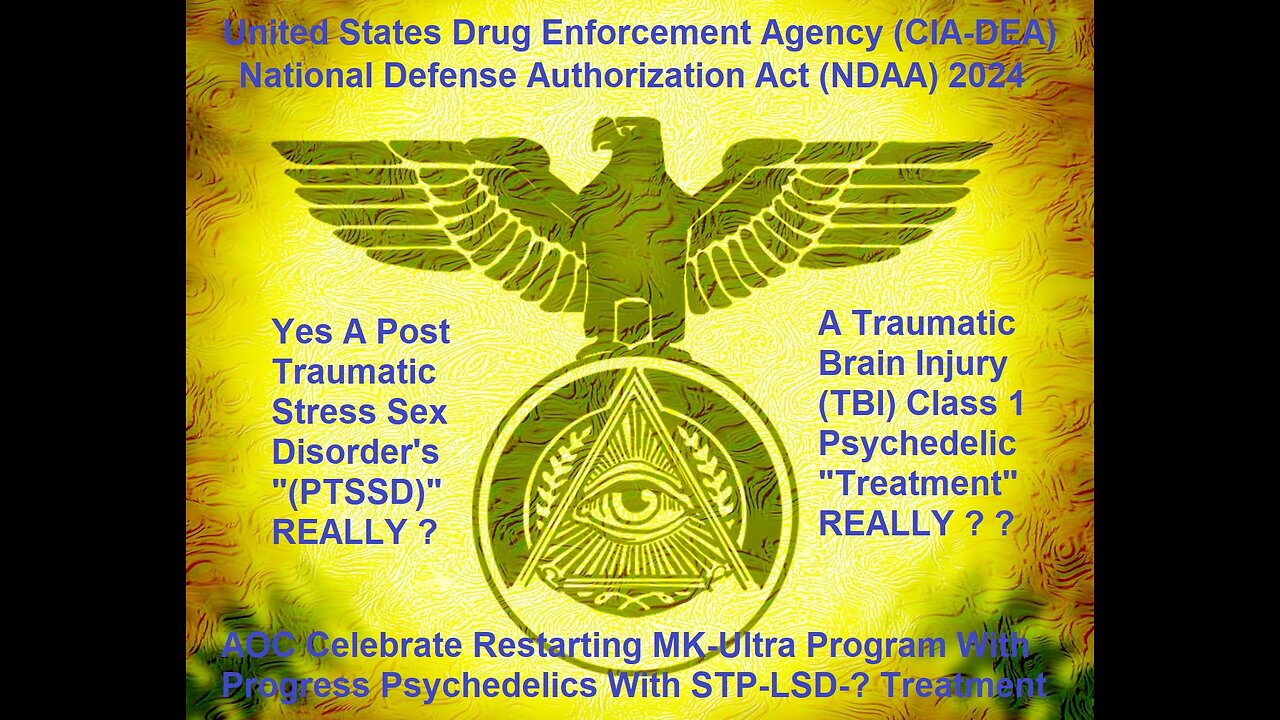
AOC Celebrate Restarting MK-Ultra Program With Progress Psychedelics Treatment
Multimillionaire Alexandria Ocasio-Cortez Celebrate Restarting MK-Ultra was a top-secret CIA project in which the agency conducted hundreds of clandestine experiments sometimes on unwitting U.S. citizens to assess the potential use of LSD and other drugs for mind control, information gathering and psychological torture. Though Project MK-Ultra lasted from 1953 until about 1973, details of the illicit program didn’t become public until 1975, during a congressional investigation into widespread illegal CIA activities within the United States and around the world.
Representative Ocasio-Cortez spoke on the House floor about her amendment that allows research on whether Schedule I Drugs Class One can treat disease. MDMA helps some vets with PTSD. Ibogaine may treat opioid addiction. Marijuana helps cancer and epilepsy patients. But these treatments aren’t available because related medical research is effectively banned.
Schedule I drugs are those that have the following characteristic according to the United States Drug Enforcement Agency (DEA):
The drug or other substance has a high potential for abuse.
The drug or other substance has no currently accepted medical treatment use in the U.S. It has a lack of accepted safety for use under medical supervision.
According to federal law, no prescriptions may be written for Schedule I substances, and they are not readily available for clinical use.
Controlled Substances & CSA Schedules
List of Schedule 1 Drugs
Medically reviewed by Leigh Ann Anderson, PharmD. Last updated on Feb 7, 2022.
Schedule I drugs are those that have the following characteristic according to the United States Drug Enforcement Agency (DEA):
The drug or other substance has a high potential for abuse.
The drug or other substance has no currently accepted medical treatment use in the U.S. It has a lack of accepted safety for use under medical supervision.
According to federal law, no prescriptions may be written for Schedule I substances, and they are not readily available for clinical use.
Commonly Abused Drugs and Substances
A substance does not need to be listed as a controlled substance by the DEA to be treated as a Schedule I substance for criminal prosecution. A controlled substance analogue (for example, a "designer drug") is a substance which is structurally or pharmacologically similar to a Schedule I or Schedule II substance, specifically used for human consumption, and is not an approved medication in the United States.
Tetrahydrocannabinol (THC, marijuana) is still considered a Schedule 1 drug by the DEA, even though some U.S. states have legalized marijuana for personal, recreational use or for medical use.
Drugs or Substances listed in DEA Schedule I may include:
Heroin (diacetylmorphine)
LSD (Lysergic acid diethylamide)
Marijuana (cannabis, THC)
Mescaline (Peyote)
MDMA (3,4-methylenedioxymethamphetamine or “ecstasy”)
GHB (gamma-hydroxybutyric acid) - except formulations in an FDA-approved drug product sodium oxybate (Xyrem) are Schedule III
Ecstasy (MDMA or 3,4-Methylenedioxymethamphetamine)
Psilocybin ("magic mushrooms")
Synthetic marijuana and analogs (Spice, K2)
Methaqualone (Quaalude)
Khat (Cathinone, Cathine)
Bath Salts (3,4-methylenedioxypyrovalerone or MDPV)
The Controlled Substances Act (CSA) schedule information displayed above applies to drugs or substances regulated under federal law. There may be variations in CSA schedules between individual states and federal law. For example, some drugs or compounds may be deemed a schedule I drug or may be listed in a different schedule in a state's specific controlled substance act, which may differ from the federal controlled substance act.
Representatives Alexandria Ocasio-Cortez (NY-14) and Dan Crenshaw (TX-02) hosted a press conference recognizing progress with a provision in the National Defense Authorization Act (NDAA) that directs the Secretary of Defense to conduct a clinical report on psychedelic treatment in military treatment facilities. Initial medical research shows promising results for the use of psychedelics in treating Post-Traumatic Stress Disorder (PTSD) and Traumatic Brain Injury (TBI). In past years, both Rep. Ocasio-Cortez and Rep. Crenshaw have separately introduced amendments to the NDAA to allow for the medical study of psychedelics. This year, a version of their amendment language was included in the original bill text for the NDAA. The NDAA, along with the psychedelics provision, is expected to pass the House on Friday. At the press conference, Reps. Ocasio-Cortez and Crenshaw were joined by Rep. Lou Correa, Co-Chair of the Congressional Psychedelics Advancing Clinical Treatments “PACT” Caucus.
Crenshaw and AOC expect to pass bill funding psychedelic clinical studies for PTSD Reps. Dan Crenshaw (R-TX) and Alexandria Ocasio-Cortez (D-NY) said Thursday they expect their bipartisan legislation to create a pathway for clinical studies for psychedelic drugs to treat post-traumatic stress disorder to pass the House in a floor vote on Friday.
Ocasio-Cortez said in a joint press conference with Crenshaw that they aim to "celebrate the enormous amount of progress being made in the study and advancement of psychedelics research and application for PTSD, our veterans community, as well as many other survivors across the country."
FIVE CONTROVERSIAL AMENDMENTS COMPLICATING MCCARTHY'S JOB OF PASSING THE NDAA
Crenshaw called the group a "wild coalition" of supporters backing the legislation spanning the ideological spectrum. "Everybody is on the same page because there's a realization that these therapies are working," he said.
"When we find something we can agree on, we just get it done," said Crenshaw. "I still can't find one member of Congress who is actually opposed to this."
Crenshaw introduced legislation in June that would create a federal grant program through the National Defense Authorization Act for research into the use of psychedelics for active duty military service members suffering from a traumatic brain injury or PTSD due to their service. The bill authorizes $15 million through the Department of Defense for studies each fiscal year using psilocybin, DMT, MDMA, and ibogaine.
Ocasio-Cortez first introduced a bill in 2019 to legalize psychedelic clinical studies for all Americans, which she said "failed a lot" at the time. Since then, however, there has been significant support from various groups that have seen benefits from psychedelics in treating a variety of medical issues.
Crenshaw said at the press conference that clinical studies and trials across the globe have shown promise for survivors of sexual assault, drug addiction, and depression. Effective July 1, Australia became the first country to legalize MDMA for PTSD and psilocybin for depression which has been resistant to other treatment options.
Recreational psychedelic drug use has surged in the U.S., more than doubling among 18- to 30-year-olds during the COVID-19 pandemic. Some researchers suggest that these drugs have been used as a coping mechanism to deal with lockdowns and corresponding financial and psychological pressure.
Ocasio-Cortez said that there is a "moral responsibility" to increase scientific experimentation for therapies that can help survivors of both mental and physical trauma through exploratory psychedelics research. "We desperately need more resource.
When asked if this would be a step toward the legalization of psychedelics, Ocasio-Cortez said that more data is needed on these "powerful" substances to determine if they should be completely removed from the Schedule I drug classification list.
Ocasio-Cortez indicated that although she, Crenshaw, and the coalition of supporters in the House believe that it will pass the floor vote, the group expects the provision to have problems passing the Senate.
The National Defense Authorization Act (NDAA) is a series of federal laws that specify the annual budget and expenditures of the U.S. Department of Defense. The NDAA authorizes fiscal year appropriations for the Department of Defense, for Department of Energy national security programs, and for the Department of State, Department of Homeland Security, and the Intelligence Community. The FY23 NDAA is a bipartisan and bicameral agreement that demonstrates strength in the face of China's threats. The NDAA authorizes funding for a 4.6% pay raise for both military service members and the Department of Defense civilian workforce, bolsters support for Ukraine and Taiwan, and rescinds the US military's Covid-19 vaccine mandate.
Here’s what’s in the $858 billion defense bill Congress has passed a bipartisan $858 billion defense bill that would give service members a hefty pay raise, bolster support for Ukraine and Taiwan, and rescind the US military’s Covid-19 vaccine mandate.
The Senate voted Thursday to pass the massive National Defense Authorization Act, known as the NDAA, with bipartisan support. It follows the House’s bipartisan approval of the legislation last week.
The legislation now goes to President Joe Biden for his signature. The White House views the removal of the mandate as “a mistake,” press secretary Karine Jean-Pierre said Monday. But she declined to say whether Biden would sign a bill that ends the requirement, noting that the president will “judge the bill in its entirety.”
The defense bill outlines the policy agenda for the Department of Defense and the US military and authorizes spending in line with the Pentagon’s priorities. But it does not appropriate the funding itself.
The must-pass legislation, which would authorize $817 billion specifically for the Department of Defense, would provide $45 billion more than Biden’s budget request earlier this year.
The increase for fiscal year 2023 is intended to address the effects of inflation and accelerate the implementation of the national defense strategy, according to the Senate Armed Services Committee. It would authorize $12.6 billion for the inflation impact on purchases, $3.8 billion for the impact on military construction projects and $2.5 billion for the impact on fuel purchases, according to a bill summary from the committee.
The NDAA also includes provisions to strengthen air power and land warfare defense capabilities, as well as cybersecurity.
And the legislation shows Congress’ continued support for helping Ukraine repel Russia’s invasion, even though several Republican lawmakers have raised questions about the ongoing US aid.
“That’s the important thing – that you don’t see any diminution in the bipartisan consensus about providing support to Ukraine, despite having heard a lot about rising concerns,” said Mark Cancian, a senior adviser at the Center for Strategic and International Studies, a think tank.
Here are some key provisions in the National Defense Authorization Act:
Support for service members and their families
The bill would provide a 4.6% increase in military basic pay for service members, the largest in 20 years. The Department of Defense’s civilian workforce would get the same raise.
It would also bump up service members’ housing allowance by 2% and require a report on a “more transparent, fair, and flexible way to calculate the basic allowance for housing,” according to a summary from the House Armed Services Committee.
The legislation would also increase the eligibility threshold for the Basic Needs Allowance, a new supplemental payment for low-income military families, to 150% of the federal poverty line, up from 130%.
The NDAA would also increase funding for commissaries to help offset higher prices. And it would create a pilot program to reimburse military families for certain child care costs related to a permanent change of station.
It would authorize the reimbursement of up to $4,000 for pet relocation expenses stemming from permanent changes of station to or from locations outside the continental US.
To address the issue of suicides among service members, the bill would require the defense secretary to compile a report on suicide rates by military occupational specialty, service and grade. It would mandate that the defense secretary brief the congressional Armed Services committees on the preliminary findings of the review no later than June 1.
Some 519 US service members died by suicide last year, according to the Pentagon. The overall suicide rate per 100,000 active-duty service members has slowly increased from 2011 to 2021.
Aid for Ukraine
The NDAA would extend and modify the Ukraine Security Assistance Initiative, as well as authorize $800 million in funding in fiscal year 2023, which is $500 million more than was contained in last year’s defense bill.
The program provides funding for the federal government to pay industry to produce weapons and security assistance to send to Ukraine, rather than drawing directly from current US stockpiles of weapons.
The funding authorization in the defense bill is intended to supplement additional money for the initiative expected in a future federal spending package, according to Sen. Rob Portman, an Ohio Republican who wrote the program into law in 2015.
Also, the defense bill would expedite the delivery of munitions to Ukraine and the replenishment of associated US stockpiles by streamlining acquisition requirements and authorizing multiyear procurement for certain munitions, according to the House Armed Services Committee. The authorization would also provide stocks of munitions to US allies and partners, as well as increase the number of munitions that would be needed if China takes action against Taiwan.
It would be the largest number of multiyear procurement contracts for munitions that the defense bill has authorized in recent history, if not ever.
One of the key concerns throughout the ongoing conflict in Ukraine has been whether the industrial bases of the US and other allied nations can meet the demand required to support Ukraine. This measure is focused on reducing bureaucratic red tape to help industry produce those weapons for Ukraine faster.
Enhanced defense partnership with Taiwan
The NDAA would establish a specific defense modernization program for Taiwan to deter aggression by China, according to Senate Foreign Relations Committee Chairman Bob Menendez, a Democrat from New Jersey.
It would authorize up to $10 billion in Foreign Military Financing grants over the next five years, enhance training and collaboration, and make available up to $2 billion in loans.
It would also give the president the authority to give Taiwan up to $1 billion in weapons and munitions.
And it would create a regional contingency stockpile, which would allow the Pentagon to put weapons in Taiwan for use if a military conflict with China arises, Cancian said.
Wary that Russia’s aggression against Ukraine might prompt China to take similar action against Taiwan, Biden has said several times that the US has an obligation to defend the self-governing island should China invade. Under Biden, as well as his predecessors, the US has sold weapons to Taiwan to strengthen its defensive capabilities.
End of military Covid-19 vaccine mandate
The bill would end the requirement that troops receive the Covid-19 vaccine. However, it would not reinstate members of the military who were discharged for refusing to get vaccinated – an amendment conservative senators unsuccessfully offered.
The controversial provision to rescind the mandate was pushed by congressional Republicans. House GOP leader Kevin McCarthy said last week that the mandate’s end is “a victory for our military and for common sense.”
But military officials and experts have warned that it could have adverse ripple effects on military readiness and the ability of service members to deploy around the world.
While White House officials have deferred to – and explicitly sided with – Defense Secretary Lloyd Austin’s opposition to rescinding the mandate, Democrats concluded that including the GOP priority was a necessity in order to get the bill across the finish line. Administration officials have quietly acknowledged that means their opposition to the vaccine language will not get in the way of the bill’s passage.
The Cold War and Project MK-Ultra
In the 1950s and 1960s—the height of the Cold War—the United States government feared that Soviet, Chinese and North Korean agents were using mind control to brainwash U.S. prisoners of war in Korea.
In response, Allan Dulles, director of the Central Intelligence Agency (CIA), approved Project MK-Ultra in 1953. The covert operation aimed to develop techniques that could be used against Soviet bloc enemies to control human behavior with drugs and other psychological manipulators.
The program involved more than 150 human experiments involving psychedelic drugs, paralytics and electroshock therapy. Sometimes the test subjects knew they were participating in a study—but at other times, they had no idea, even when the hallucinogens started taking effect.
Many of the tests were conducted at universities, hospitals or prisons in the United States and Canada. Most of these took place between 1953 and 1964, but it’s not clear how many people were involved in the tests—the agency kept notoriously poor records and destroyed most MK-Ultra documents when the program was officially halted in 1973.
LSD and Sidney Gottlieb
The CIA began to experiment with LSD (lysergic acid diethylamide) under the direction of agency chemist and poison expert Sidney Gottlieb. He believed the agency could harness the drug’s mind-altering properties for brainwashing or psychological torture.
Under the auspices of Project MK-Ultra, the CIA began to fund studies at Columbia University, Stanford University and other colleges on the effects of the drug. After a series of tests, the drug was deemed too unpredictable for use in counterintelligence.
MK-Ultra also included experiments with MDMA (ecstasy), mescaline, heroin, barbiturates, methamphetamine and psilocybin (“magic mushrooms”).
Operation Midnight Climax
Operation Midnight Climax was an MK-Ultra project in which government-employed prostitutes lured unsuspecting men to CIA “safe houses” where drug experiments took place.
The CIA dosed the men with LSD and then—while at times drinking cocktails behind a two-way mirror—watched the drug’s effects on the men’s behavior. Recording devices were installed in the prostitutes’ rooms, disguised as electrical outlets.
Most of the Operation Midnight Climax experiments took place in San Francisco and Marin County, California, and in New York City. The program had little oversight and the CIA agents involved admitted that a freewheeling, party-like atmosphere prevailed.
An agent named George White wrote to Gottlieb in 1971: “Of course I was a very minor missionary, actually a heretic, but I toiled wholeheartedly in the vineyards because it was fun, fun, fun. Where else could a red-blooded American boy lie, kill and cheat, steal, deceive, rape and pillage with the sanction and blessing of the All-Highest?”
The Death of Frank Olson
Frank Olson was a scientist who worked for the CIA. At a 1953 CIA retreat, Olson drank a cocktail that had been secretly spiked with LSD.
A few days later, on November 28, 1953, Olson tumbled to his death from the window of a New York City hotel room in an alleged suicide.
The family of Frank Olson decided to have a second autopsy performed in 1994. A forensics team found injuries on the body that had likely occurred before the fall. The findings sparked conspiracy theories that Olson might have been assassinated by the CIA.
After prolonged legal proceedings, Olson’s family was awarded a settlement of $750,000, and received a personal apology from President Gerald Ford and then-CIA Director William Colby.
Ken Kesey and Other MK-Ultra Participants
Ken Kesey, author of the 1962 novel One Flew Over the Cuckoo’s Nest, volunteered for MK-Ultra experiments with LSD while he was a college student at Stanford University.
Kesey later went on to promote the drug, hosting LSD-fueled parties that he called “Acid Tests.”
Acid Tests combined drug use with musical performances by bands including the Grateful Dead and psychedelic effects such as fluorescent paint and black lights. These parties influenced the early development of hippie culture and kick-started the 1960s psychedelic drug scene.
Other notable people who reportedly volunteered for CIA-backed experiments with LSD include Robert Hunter, the Grateful Dead lyricist; Ted Kaczynski, better known as the “Unabomber”; and James Joseph “Whitey” Bulger, the notorious Boston mobster.
Church Committee
In 1974, New York Times journalist Seymour Hersh published a story about how the CIA had conducted non-consensual drug experiments and illegal spying operations on U.S. citizens. His report started the lengthy process of bringing long-suppressed details about MK-Ultra to light.
The following year, President Ford—in the wake of the Watergate scandal and amid growing distrust of the U.S. government—set up the United States President’s Commission on CIA Activities within the United States to investigate illegal CIA activities, including Project MK-Ultra and other experiments on unsuspecting citizens.
The Commission was led by Vice President Nelson Rockefeller and is commonly referred to as the Rockefeller Commission.
The Church Committee—helmed by Idaho Democratic Senator Frank Church—was a larger investigation into the abuses of the CIA, FBI and other U.S. intelligence agencies during and after the resignation of President Richard M. Nixon.
The Church Committee delved into plots to assassinate foreign leaders, including Cuban dictator Fidel Castro and Congolese independence leader Patrice Lumumba. It also uncovered thousands of documents related to MK-Ultra.
These revelations resulted in Ford’s 1976 Executive Order on Intelligence Activities that prohibited “experimentation with drugs on human subjects, except with the informed consent, in writing and witnessed by a disinterested party, of each such human subject.”
The family of Frank Olson decided to have a second autopsy performed in 1994. A forensics team found injuries on the body that had likely occurred before the fall. The findings sparked conspiracy theories that Olson might have been assassinated by the CIA.
After prolonged legal proceedings, Olson’s family was awarded a settlement of $750,000, and received a personal apology from President Gerald Ford and then-CIA Director William Colby.
Ken Kesey and Other MK-Ultra Participants
Ken Kesey, author of the 1962 novel One Flew Over the Cuckoo’s Nest, volunteered for MK-Ultra experiments with LSD while he was a college student at Stanford University.
Kesey later went on to promote the drug, hosting LSD-fueled parties that he called “Acid Tests.”
Acid Tests combined drug use with musical performances by bands including the Grateful Dead and psychedelic effects such as fluorescent paint and black lights. These parties influenced the early development of hippie culture and kick-started the 1960s psychedelic drug scene.
Other notable people who reportedly volunteered for CIA-backed experiments with LSD include Robert Hunter, the Grateful Dead lyricist; Ted Kaczynski, better known as the “Unabomber”; and James Joseph “Whitey” Bulger, the notorious Boston mobster.
Church Committee
In 1974, New York Times journalist Seymour Hersh published a story about how the CIA had conducted non-consensual drug experiments and illegal spying operations on U.S. citizens. His report started the lengthy process of bringing long-suppressed details about MK-Ultra to light.
The following year, President Ford—in the wake of the Watergate scandal and amid growing distrust of the U.S. government—set up the United States President’s Commission on CIA Activities within the United States to investigate illegal CIA activities, including Project MK-Ultra and other experiments on unsuspecting citizens.
The Commission was led by Vice President Nelson Rockefeller and is commonly referred to as the Rockefeller Commission.
The Church Committee—helmed by Idaho Democratic Senator Frank Church—was a larger investigation into the abuses of the CIA, FBI and other U.S. intelligence agencies during and after the resignation of President Richard M. Nixon.
The Church Committee delved into plots to assassinate foreign leaders, including Cuban dictator Fidel Castro and Congolese independence leader Patrice Lumumba. It also uncovered thousands of documents related to MK-Ultra.
These revelations resulted in Ford’s 1976 Executive Order on Intelligence Activities that prohibited “experimentation with drugs on human subjects, except with the informed consent, in writing and witnessed by a disinterested party, of each such human subject.”
However, less well-known is the CIA project called “MK Ultra” that exploited people of color (POC) and other vulnerable groups to test the human limits of drugs like LSD for its use as a “mind-control” agent.
Many have heard of the infamous Tuskegee Syphilis Study, in which Black American men with syphilis were denied treatment and left to suffer through the course of the disease and die so that white scientists could study the effects of syphilis on the human body. However, less well-known is the CIA project called “MK Ultra” that exploited people of color (POC) and other vulnerable groups to test the human limits of drugs like LSD for its use as a “mind-control” agent.
The Creation of Project MK Ultra
In 1975, news emerged about CIA-sponsored research with LSD. Due to fears, stemming from the Cold War, that the Soviets had developed methods for “mind-control” (Marks, 1979) and that LSD could be used as biochemical warfare (Dyck, 2008), the CIA project MK Ultra was created to test the potential of LSD for “mind control,” “brainwashing,” and as a “truth serum” for interrogating spies.
It was discovered that over 80 private and public universities, prisons, and hospitals conducted LSD experiments on civilians, prisoners, and patients with and without knowledge that the research funds were obtained through the CIA MK Ultra program (Richert & Dyck, 2020). Although evidence of project MK Ultra was ordered to be destroyed by CIA director Richard Helms, some records survived and were illuminated during US Senate hearings (Richert & Dyck, 2020; Select Committee on Intelligence and Committee on Human Resources, 1977) as well as through scientific publications with connections to MK Ultra.
Diving Deeper: Our Research
While one might assume such a nefarious project would be kept top secret, the products of this research were published in publicly accessible, peer-reviewed scientific journals. Our research team at the University of Ottawa examined 49 such research articles published from the 1950s to the 1970s that administered psychedelics to test subjects, including LSD, DMT, mescaline, psilocybin, and THC. We sought to understand how and to what extent people of color and other vulnerable groups were exploited during this first wave of psychedelic research in the United States. Specifically, we examined the race and ethnicity of the participants, the recruitment strategy, study methodology, and potential dangers across the selected studies, and we uncovered recurring themes surrounding safety and ethics that gave us pause.
Our Findings Overall, we found that the researchers conducted brutal experiments on prisoners and people with psychotic disorders, in which they gave participants extremely high doses of psychedelics far too often and for far too long.
Across all of the studies analyzed, there were issues surrounding use of incarcerated populations, coercive incentives, unsafe dosing, questionable scientific merit, and oppressive set and setting. Overall, we found that the researchers conducted brutal experiments on prisoners and people with psychotic disorders, in which they gave participants extremely high doses of psychedelics far too often and for far too long. Almost 30% of the studies reported using POC, half of the studies used incarcerated participants, and 15% used participants with psychotic disorders. Further, over three quarters of the studies used a high-risk dosing schedule, and just under 90% of studies had at least one ethical violation.
Although roughly 30% of the examined studies reported using POC (mostly Black American men, as well as a few Puerto Rican men), many did not report the race or ethnicity of the participants; however, we investigated the recruitment sites used, and we found that people of color, predominantly Black Americans, were significantly overrepresented in the prisons from which participants were recruited. One of these sites was the Addiction Research Center (ARC) in Lexington, Kentucky.
Worse, the prisoners at ARC were offered heroin as payment for participating in research studies, which they could use after the study or bank for later.
This was a prison built for doing research on inmates. Worse, the prisoners at ARC were offered heroin as payment for participating in research studies, which they could use after the study or bank for later. This was unquestionably unethical, but it was also particularly coercive and exploitative, considering the fact that prisoners at ARC were often there for drug-related offenses. Researchers were, therefore, giving heroin to prisoners who also might have been struggling with substance use disorders.
In another study, Black participants were given more than double the dose (180 mcg) of LSD, compared to white participants (75 mcg), and white participants endured 8 days of LSD administration, while Black participants endured chronic LSD administration for up to 85 days
Some of the studies that did report the participants’ race also documented treating the participants of color worse than white participants. For example, despite knowledge of the importance of set and setting, in one study, the researchers reported that the white participants, who were living freely, were given LSD in the researcher’s home under conditions designed to reduce anxiety, whereas the participants of color, who were prisoners, were given LSD in a prison ward in which comfort or anxiety were not considerations (Abramson, 1960). In another study, Black participants were given more than double the dose (180 mcg) of LSD, compared to white participants (75 mcg), and white participants endured 8 days of LSD administration, while Black participants endured chronic LSD administration for up to 85 days (Isbell, et al., 1956)! In many cases, the prisoners did not even know what they had been given. One prisoner, who was essentially being tortured, asked many times to leave the experiment but was forced to stay.
Excerpts from the Research Articles Studied
We’ve included some excerpts below from the research articles that were produced from these experiments.
A schizophrenic participant was quoted pleading, “Dr. X, this is serious business—we are pathetic people—don’t play with us” (Cholden et al., 1955, p. 217).
In another study, a chronically ill Black participant was described to be of “low intelligence, with only 2 years’ education and an impoverished socioeconomic background.” The researchers then go on to describe him as if he were an animal. They reported that he had a “wild frightened look” and “he became quiet and no longer required restraints, which had been necessary during the previous experiment” (Monroe, et al., 1957, pp. 633–634).
In another experiment, with respect to one of the incarcerated Black participants, the researchers reported, “After recovery from this severe reaction, the patient wished to drop out of the experiment but after considerable persuasion agreed to continue. He was started on 50 mcg LSD once daily, and this dose was increased until he again received 180 mcg of LSD on the 22nd day” (Isbell et al., 1956, p. 475).
In an interview, Edward M. Flowers, the only surviving prisoner research participant to have been located, reflected on his participation in LSD experiments at ARC saying, “they used my ass and took advantage of me…” (Campbell & Stark, 2015).
Socially Responsible and Culturally-Competent Research
Addressing these research abuses begs the question, “What does socially responsible and culturally-competent research look like?” Ethical research mandates that participants are treated in accordance with the principles outlined in the Belmont Report: beneficence, justice, and respect for persons. Ethical research also requires the inclusion of historically disadvantaged and exploited groups, particularly Black and Indigenous communities. Inclusion does not simply mean diverse participant pools (although this is important too), but also truly inclusive (non-tokenized) representation of Black, Indigenous, and people of color (BIPOC) across all echelons of the research process (e.g., in research labs, as principal investigators, on journal editorial boards, etc.), writing and publishing on culturally-inclusive topics, and that participants and experts are treated with care and respect.
Within Black and Indigenous communities, there remains a strong cultural memory of research abuses perpetrated against them by white, Western researchers, and, as a result, BIPOC may not feel safe or comfortable in clinical settings with white researchers and clinicians.
Within Black and Indigenous communities, there remains a strong cultural memory of research abuses perpetrated against them by white, Western researchers, and, as a result, BIPOC may not feel safe or comfortable in clinical settings with white researchers and clinicians. Thus, additional measures must be taken to ensure that BIPOC participants feel safe and comfortable. There are many resources with information on culturally-competent research methods (e.g., Eriacho, 2020; George et al., 2020; Williams et al., 2020. Some recommendations include community-based participatory research with BIPOC communities (ensuring appropriate compensation for time and expertise so as not to perpetuate exploitation), culturally-informed therapeutic models and clinical settings, offering ethnoracially-matched clinicians for participants, anti-racism and cultural competency training for all researchers and clinicians, as well as basic trust and respect (Eriacho, 2020; George et al.,, 2020; Williams et al., 2020).
Next Steps Moving Forward
You might be wondering, “What should be done with this unethical research?” There has yet to be a consensus reached as to the handling of this research, and it continues to be used and cited today, albeit critically. However, the question remains: Should it still be used and cited or done away with? One possibility is to handle this research the same way as the literature resulting from the Nazi human experiments. The scientific community has largely agreed that the Nazi experiments were so appallingly unethical that any literature citing that research should also be considered unethical and be retracted (Moe, 1984). On the other hand, it is also conceivable that the participants who suffered so immensely for this research might not want it to go to waste and be forgotten about.
It is only appropriate that the thoughts and feelings of the research participants, themselves, be considered with regard to the handling of this literature. Unfortunately, most of the original participants are no longer alive to ask, so their descendants and the impacted communities of color should be consulted in their stead.
Another potential next step towards rectifying this injustice might be to understand the toll this research has taken, and continues to take, on the affected communities of color, and implement reparations.
Another potential next step towards rectifying this injustice might be to understand the toll this research has taken, and continues to take, on the affected communities of color, and implement reparations. For example, how were the Black communities in Lexington, KY, impacted by the ARC experiments, and what are the impacts of these unethical experiments today for these communities? How would they like to be compensated, and what would they like done with the resulting research findings?
The Future of Psychedelic Research
People of color, particularly Black Americans, and other vulnerable groups (prisoners and people with psychotic disorders) were exploited and even tortured during the first wave of psychedelic research in the United States. Ethically speaking, it is critical that the current wave of psychedelic research is culturally inclusive so that resulting treatments are safe, effective, and accessible for a diverse society, and honor Indigenous communities through reciprocity. It is also critical that psychedelic researchers acknowledge the contributions, however painful and non-consensual, of Black, Indigenous, and people of color to the field, whose bodies were used to gain knowledge to benefit others and without whom the field would not be where it is today. Finally, today’s researchers must be cognizant of the research abuses committed by white, Western researchers against POC in early psychedelic research and take responsibility to address the ways in which these research abuses have impacted and continue to impact these communities.
https://www.govinfo.gov/content/pkg/BILLS-118hr2670rh/pdf/BILLS-118hr2670rh.pdf
What Was MK-Ultra, The CIA’s Top-Secret Cold War Research Program?
During the 1950s and '60s, the CIA used brainwashing, hypnosis, and torture on thousands of subjects brutalized by the infamous Project MK-Ultra experiments.
Though they may sound like science fiction and though the CIA tried to deny them for years, the mind-control experiments of project MK-Ultra were all too real. For more than a decade at the height of the Cold War, CIA researchers abused helpless subjects in some of the most disturbing experiments in history.
Convinced that the Soviet Union had developed mind-control capabilities, the CIA tried to do the same with MK-Ultra starting in 1953. What followed was an expansive program undertaken across 80 institutions, universities, and hospitals. Each one carried out torturous experiments, including electrocution, verbal and sexual abuse, and dosing subjects with massive quantities of LSD.
What’s more, these experiments often used unwitting subjects who were left with permanent psychological damage.
Unsurprisingly, the CIA conducted the project with the utmost secrecy, even giving it multiple code names. And when it finally ended in the 1970s, most of the records pertaining to it were destroyed on the orders of the director of the CIA himself — that is, all but a small misfiled cache accidentally left intact.
Eventually, those documents and several government investigations helped bring the project to light. Today, the public even has access to some 20,000 documents concerning project MK-Ultra’s mind-control experiments.
But even this provides only a small window into what is perhaps one of the largest and most heinous government programs and cover-ups in American history.
The Birth Of Project MK-Ultra At The Height Of The Cold War
The MK-Ultra program also operated under the cryptonyms MKNAOMI and MKDELTA. The “MK” indicated that the project was sponsored by the Technical Services Staff of the CIA and “Ultra” was a nod to the codename that had been used for classified documents during World War II.
As the Cold War moved into its peak era in the early 1950s, the American intelligence community grew increasingly obsessed with the growing technological advancements of the Soviet Union.
The U.S. government feared, in particular, that it was already falling behind the Soviet Union in regard to novel interrogation techniques. Reports during the Korean War (which later proved erroneous) suggested that North Korean and Soviet forces had developed mind-control capabilities and the U.S. couldn’t let them have that advantage.
Thus, on April 13, 1953, then-director of the nascent CIA Allen Welsh Dulles sanctioned project MK-Ultra. The program was quickly headed by chemist and poison expert Sidney Gottlieb, who was known in covert circles as the “Black Sorcerer.”
One of Gottlieb’s original goals was to create a truth serum that could be used against Soviet spies and prisoners of war in order to gain intelligence.
Unsurprisingly, perhaps, generating a truth serum proved difficult. Instead, researchers believed that a kind of mind control could be achieved by placing the subject in a heavily altered mental state — typically with the help of wildly experimental drugs.
According to journalist Stephen Kinzer, Gottlieb realized that in order to control the mind, he’d have to wipe it first. “Second, you had to find a way to insert a new mind into that resulting void,” Kinzer explained. “We didn’t get too far on number two, but he did a lot of work on number one.”
In Gottlieb’s own words, project MK-Ultra’s mind experiments extensively researched extensively how drugs could “enhance the ability of individuals to withstand privation, torture and coercion,” as well as “produce amnesia, shock and confusion.”
A declassified document from 1955 added that MK-Ultra sought to observe “materials which will cause the victim to age faster/slower in maturity” and “substances which will promote illogical thinking and impulsiveness to the point where the recipient would be discredited in public.”
With these goals in mind, project MK-Ultra scientists began devising mind-altering experiments with insidious goals — and disastrous results.
How Did MK-Ultra’s Mind-Control Experiments Work?
From the beginning, MK-Ultra’s mind-control experiments were conducted with great secrecy in part because the CIA was well aware of the dubious ethics involved. For secrecy’s sake, the program’s 162 experiments were spread out across multiple cities, college campuses, prisons, and hospitals. In total, 185 researchers were involved — and many of them didn’t even know that their work was meant for the CIA.
In all of these dozens of settings, the primary experimental method often involved administering large quantities of various mind-altering substances in hopes of wiping the human mind in the way Gottlieb wanted to.
Subjects were dosed with LSD, opioids, THC, and the synthetic government-created super hallucinogen BZ, as well as widely available substances such as alcohol. Researchers would also sometimes administer two drugs with opposite effects (such as a barbiturate and an amphetamine) simultaneously and observe their subjects’ reactions, or give subjects already under the influence of alcohol a dose of another drug like LSD.
Aside from drugs, researchers also used hypnosis, often in an effort to create fear in subjects that could then be exploited to gain information. Researchers went on to investigate the effects of hypnosis on the results of polygraph tests and its implications for memory loss.
Wikimedia CommonsDonald E. Cameron, who had been present at the Nuremberg Trials as a psychiatric evaluator for leading Nazi Rudolf Hess, was one of the lead researchers in MK-Ultra’s mind experiments.
MK-Ultra participants were also subjected to experimentation involving electroconvulsive therapy, aural stimulation, and paralytic drugs.
Meanwhile, experimenter Donald Cameron (the first chairman of the World Psychiatric Association and the president of the American and Canadian psychiatric associations) drugged patients and repeatedly played tapes of noises or suggestions while they were comatose for long periods of time, hoping to correct schizophrenia by erasing memories in order to reprogram subjects’ minds.
In reality, these tests left his subjects comatose for months at a time and permanently suffering from incontinence and amnesia.
John C. Lilly, a noted animal behaviorist, was also involved in the experiments. For his research in human communication with dolphins, he created the first sensory deprivation flotation tank. MK-Ultra scientists commissioned the tank to create a sensory-free environment for their subjects to experience their acid trips without the stimuli of the outside world.
With such an arsenal of tools at their disposal, the project MK-Ultra mind-control experiments succeeded in severely disrupting the human mind, but at great cost to its unwitting subjects.
In 1953, the period following the Korean War was an uneasy one in the United States, which saw itself in a life or death struggle with the Soviet Union. Increasingly, the U.S. saw an entirely new field of battle in the human mind.
In 1952, Allen Dulles was appointed director of the U.S.' Central Intelligence Agency (CIA). Speaking to a group of Princeton University alumni on April 10, 1953, Dulles expressed his concern saying, "I wonder, however, whether we clearly perceive the magnitude of the problem, whether we realize how sinister the battle for men’s minds has become in Soviet hands. We might call it, in its new form, 'brain warfare.'"
Movies such as 1962's The Manchurian Candidate reflected the fears of that time. It portrayed a former prisoner of war who is brainwashed and becomes an unwitting assassin for an international Communist conspiracy.
MK-Ultra
On April 13, 1953, Dulles approved the MK-Ultra Program, which was a top-secret program that would use biological and chemical materials, hypnosis, sensory deprivation, isolation, verbal and sexual abuse and torture to extract information from the enemy, and render him incapacitated.
A goal of the program was to produce a "truth serum" for extracting information from suspected Soviet spies. The CIA also hoped to use hypnosis to increase the ability to learn and recall complex information, and to recall complicated arrangements of physical objects.
Some of the stated goals of the MK-Ultra program were to create substances that would:
1. Promote illogical thinking and impulsiveness so that a recipient would be discredited in public
2. Increase mental activity and perception
3. Cause a victim to age faster or slower
4. Cause temporary or permanent brain damage and loss of memory
5. Enhance the ability to withstand privation, torture, and coercion during interrogation
6. Produce amnesia for events both preceding and during their use
7. Produce shock and confusion over extended periods of time
8. Produce physical disablement, such as paralysis of the legs
9. Alter personality structure causing the recipient to become dependent upon another person
10. Lower ambition and working efficiency
11. Weaken or distort eyesight or hearing
12. Knock someone out and be surreptitiously administered in drinks, food, cigarettes, or as an aerosol
13. Make it impossible for someone to perform physical activity.
LSD was the preferred drug of choice
44 colleges and universities, 15 research foundations and pharmaceutical companies, 12 hospitals and clinics, and three penal institutions across North America were used for MK-Ultra research that included administering LSD, painkillers, and other drugs.
The first medical centers to receive grants were Boston Psychopathic Hospital (later renamed Massachusetts Mental Health Center), New York’s Mt. Sinai and Columbia hospitals, the University of Illinois Medical School, and the Universities of Oklahoma and Rochester.
The CIA was especially interested in LSD, or lysergic acid diethylamide, which was first discovered in Switzerland in 1938. LSD produced mental states similar to those known to occur in schizophrenia: depersonalization, psychic disorganization, and disintegration. The major effect of the drug was the breakdown of a subject’s character defenses for handling anxiety, which was just what the CIA was looking for.
The CIA administered LSD to their own employees, military personnel, doctors, government agents, and members of the general public, often without their knowledge or informed consent. This is a violation of the Nuremberg Code which is a set of research ethics principles for human experimentation that was created as a result of the Nuremberg trials at the end of WWII.
While he was a graduate student at Stanford University, writer Ken Kesey worked nights at the Menlo Park Veterans' Hospital, which had been given LSD to test. Kesey volunteered to take psychoactive drugs such as LSD and psilocybin.
What came out of Kesey's experiences with psychoactive substances was his acclaimed novel One Flew Over the Cuckoo's Nest. Kesey was so enamored of LSD that he went on to form the "Merry Pranksters", a group that traveled around the U.S. in a psychedelically painted bus named "Furthur", and encouraged everyone they met to try LSD.
The Merry Pranksters and Kesey were unforgettably portrayed by author Tom Wolfe in his 1968 book, The Electric Cool Aid Acid Test.
Other test subjects included prisoners who were especially easy to sign up to be test subjects in exchange for additional privileges or a commuted sentence.
In 1957, the F.B.I.'s former "most wanted" man, Whitey Bulger was serving a sentence at an Atlanta penitentiary when he signed up to be a test subject. Bulger wrote about his experience taking LSD: "Total loss of appetite. Hallucinating. The room would change shape. Hours of paranoia and feeling violent. We experienced horrible periods of living nightmares and even blood coming out of the walls. Guys turning to skeletons in front of me. I saw a camera change into the head of a dog. I felt like I was going insane."
Across the border in Montreal, Canada, inhuman experiments were being conducted by British psychiatrist Donald Ewen Cameron at the Allan Memorial Institute of McGill University. On patients who had come into the hospital suffering from relatively mild conditions such as anxiety or postpartum depression, Cameron subjected them to electroconvulsive therapy at thirty to forty times the normal power, paralytic drugs, and he put them into drug-induced comas for up to three months at a time.
Not surprisingly, many of these patients suffered permanent effects, while at the same time, Cameron became the first chairman of the World Psychiatric Association and president of the American and Canadian psychiatric associations. Author John Marks chronicled these shameful events in his 1979 book, The Search for the Manchurian Candidate.
The beginning of the end
In 1953, Ph.D. biochemist Frank Olson was assigned to the Army's Chemical Corps’ Special Operations Division (SOD) at Fort Detrick, Maryland. He attended a three-day working SOD-CIA retreat at an isolated lodge in western Maryland, where the head of MK-Ultra, Dr. Sidney Gottlieb was also present.
Gottlieb laced a bottle of Cointreau with LSD and offered it to the guests. While the others soon recovered, Olson continued to experience anxiety and mental confusion for days after being dosed. The CIA moved him to New York City to see a doctor affiliated with the MK-Ultra Program who believed he could help Olson. Instead, Olson went out the window of his 13th story hotel room, possibly voluntarily, and left behind a wife and three children. Olson's death was attributed to suicide.
In December 1974, the New York Times writer Seymour Hersh published a story about the CIA's misdeeds which prompted then-President Gerald Ford to appoint his Vice-President Nelson Rockefeller to head of a blue-ribbon panel to investigate.
The report by the Rockefeller Commission described the death of an unnamed civilian who had been given LSD by the CIA then had plunged from a New York hotel window. The Olson family recognized their husband and father, and sued the U.S. government. They received $750,000 from Congress, and a personal apology from President Ford.
In 1976, President Ford issued an Executive Order which prohibited "experimentation with drugs on human subjects, except with the informed consent, in writing and witnessed by a disinterested party, of each such human subject." Later Executive Orders by Presidents Jimmy Carter and Ronald Reagan expanded this directive to apply to any human experimentation.
In 1977, former Massachusetts Senator Edward Kennedy oversaw congressional hearings that investigated the effects of the MK-Ultra Program. The hearings were unable to consult MK-Ultra records because in 1973, CIA director Richard Helms had insisted that all records relating to the program be destroyed. However, a cache of 20,000 documents that had been misfiled survived, and they were investigated during the 1977 Senate Hearings.
In a November 27, 2012 New York Times article, Frank Olson's son Eric said of the battle to learn the truth about his father's death, "We want justice. This has cost me an immense amount of time and years of my life."
MK-Ultra is a popular trope
The MK-Ultra Program has been portrayed in books and movies, such as the 1990 film, Jacob's Ladder, 1997's Conspiracy Theory, 2015's American Ultra, and in the various Jason Bourne books and movies starring Matt Damon and written by Robert Ludlum.
On television, it was portrayed in the 1998 Canadian series The Sleep Room, and in season 1 of Stranger Things where Dr. Martin Brenner was involved in MK-Ultra, and Eleven was born to an MK-Ultra test subject. The 2017 Netflix documentary Wormwood tells the story of Frank Olson.
Stephen King's novel Firestarter is based on MK-Ultra, the game Call of Duty: Black Ops concerns the game's protagonist being turned into a Soviet sleeper agent, and the company T.H.Seeds of Amsterdam named one of its cannabis strains MK-Ultra.
CIA Mind Control and CIA Secret Experiments use of biological and chemical materials
MK-ULTRA Three days after his speech decrying Soviet tactics, Dulles approved the beginning of MK-Ultra, a top-secret CIA program for “covert use of biological and chemical materials.” “American values” made for good rhetoric, but Dulles had far grander plans for the agency’s Cold War agenda.
MK-Ultra’s “mind control” experiments generally centered around behavior modification via electro-shock therapy, hypnosis, polygraphs, radiation, and a variety of drugs, toxins, and chemicals. These experiments relied on a range of test subjects: some who freely volunteered, some who volunteered under coercion, and some who had absolutely no idea they were involved in a sweeping defense research program. From mentally-impaired boys at a state school, to American soldiers, to “sexual psychopaths” at a state hospital, MK-Ultra’s programs often preyed on the most vulnerable members of society. The CIA considered prisoners especially good subjects, as they were willing to give consent in exchange for extra recreation time or commuted sentences.
New World Order National Anthem "The Ostrich" Lyrics by Steppenwolf 1968 A.C.E.
Welcome To The New World Order - The Year Zero - National Anthem of the United States of America and Confederate States of America and New World Order National Anthem "The Ostrich" Lyrics in 1968 A.C.E.
The Conspiracy to Rule Your Mind chronicles how the ruling elite have established global domination and the ability to effect the thoughts, decisions, and world view of human beings across the globe by systematically infiltrating the media, academia, industry, military and political factions under the guise of upholding democracy.
Learn how this malevolent consortium has dedicated centuries to realize an oppressive and totalitarian rule through any means necessary, not limited to drug trafficking, money laundering, terror attacks and financial crisis within the world economy.
Worldwide tyranny is already in full effect, the food we eat and the air we breathe are not off limits. Will we be able to stop this madness before we become an electronically monitored, cashless society wherein ever man, woman and child is micro chipped?
Everything you want to know what could be more terrifying than being trafficked for sex? Being murdered in a ritual sacrifice. And even worse than that would be being murdered in a ritual sacrifice so wealthy elite cabalists can harvest your adrenal glands to get the compound Adrenochrome they need to prolong their decrepit lives!
The New World Order is Upon Us - Preserve your liberty by being Prepared ! - We The People of the New World Order Thank You.
-
 22:07
22:07
What If Everything You Were Taught Was A Lie?
7 days agoAmerica Remember Islam A Religion Peace & This What Muslim Did To Females Is Hard To Stomach
1.28K5 -
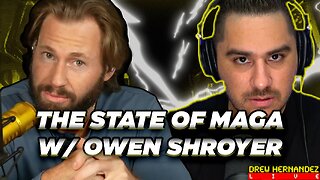 LIVE
LIVE
Drew Hernandez
22 hours agoTHE CURRENT STATE OF MAGA 2025 W/ GUEST: OWEN SHROYER
980 watching -
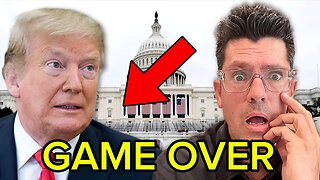 34:21
34:21
Stephen Gardner
4 hours agoThey have NO IDEA what they just UNLEASHED!!
12.1K42 -
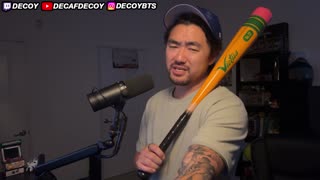 3:08:15
3:08:15
Decoy
4 hours agoFinally
34.2K10 -
 2:55:01
2:55:01
TimcastIRL
4 hours agoTrump Calls Democrat RETARDED, Whistleblower EXPOSES Democrat FRAUD | Timcast IRL
177K50 -
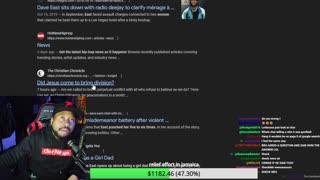 LIVE
LIVE
Akademiks
3 hours agoMeg Thee Stallion spent $2 mil on lawyers to win $59k vs Milagro! 50 Cent BURIES Diddy. SNAKES HIM!
1,064 watching -
 LIVE
LIVE
SpartakusLIVE
4 hours agoI'M BACK from Florida || The RETURN to the Spartan Stronghold
414 watching -
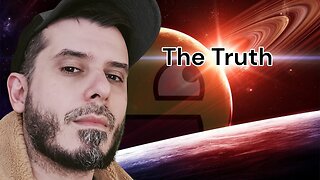 1:38:45
1:38:45
Joker Effect
3 hours agoWhy is everything so DIFFICULT?! Cuffem, Gypsy Crusader, WVAGABOND is getting SUED?! IDuncle is mad!
16.1K1 -
 54:46
54:46
Flyover Conservatives
22 hours agoInside the Kill Zones: Kidnappings, Camps & the War on Nigerian Christians Exposed - Judd Saul | FOC Show
20.6K1 -
 1:02:35
1:02:35
MattMorseTV
4 hours ago $20.94 earned🔴We just got the CONFIRMATION.🔴
33.9K68